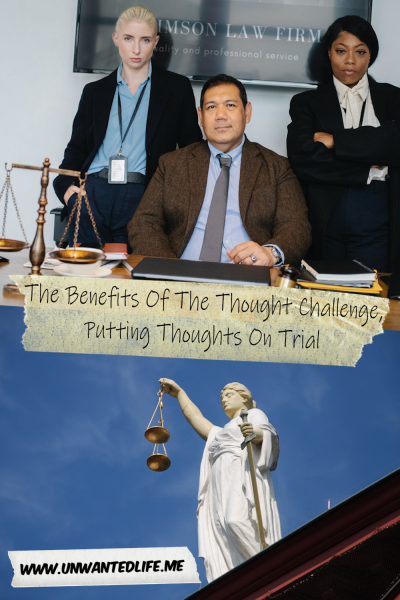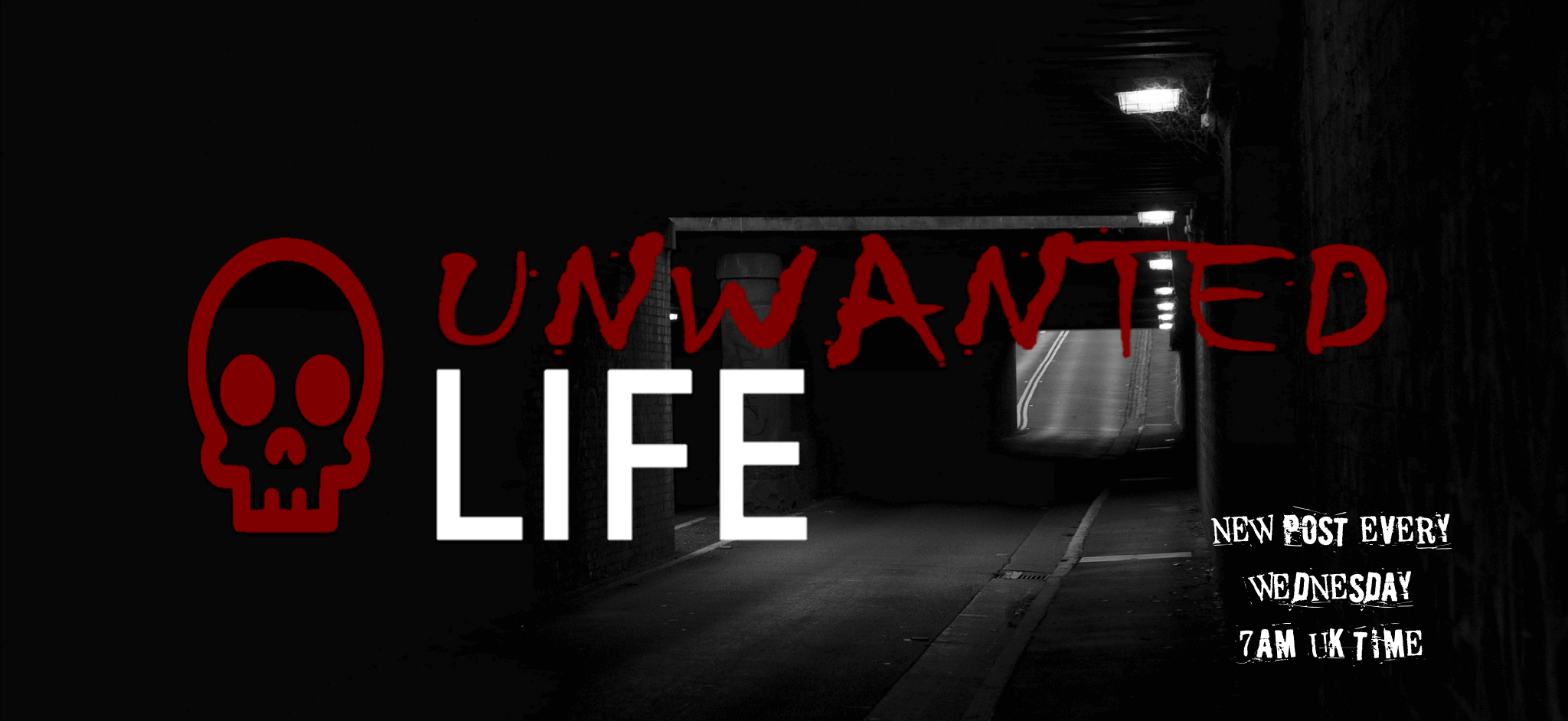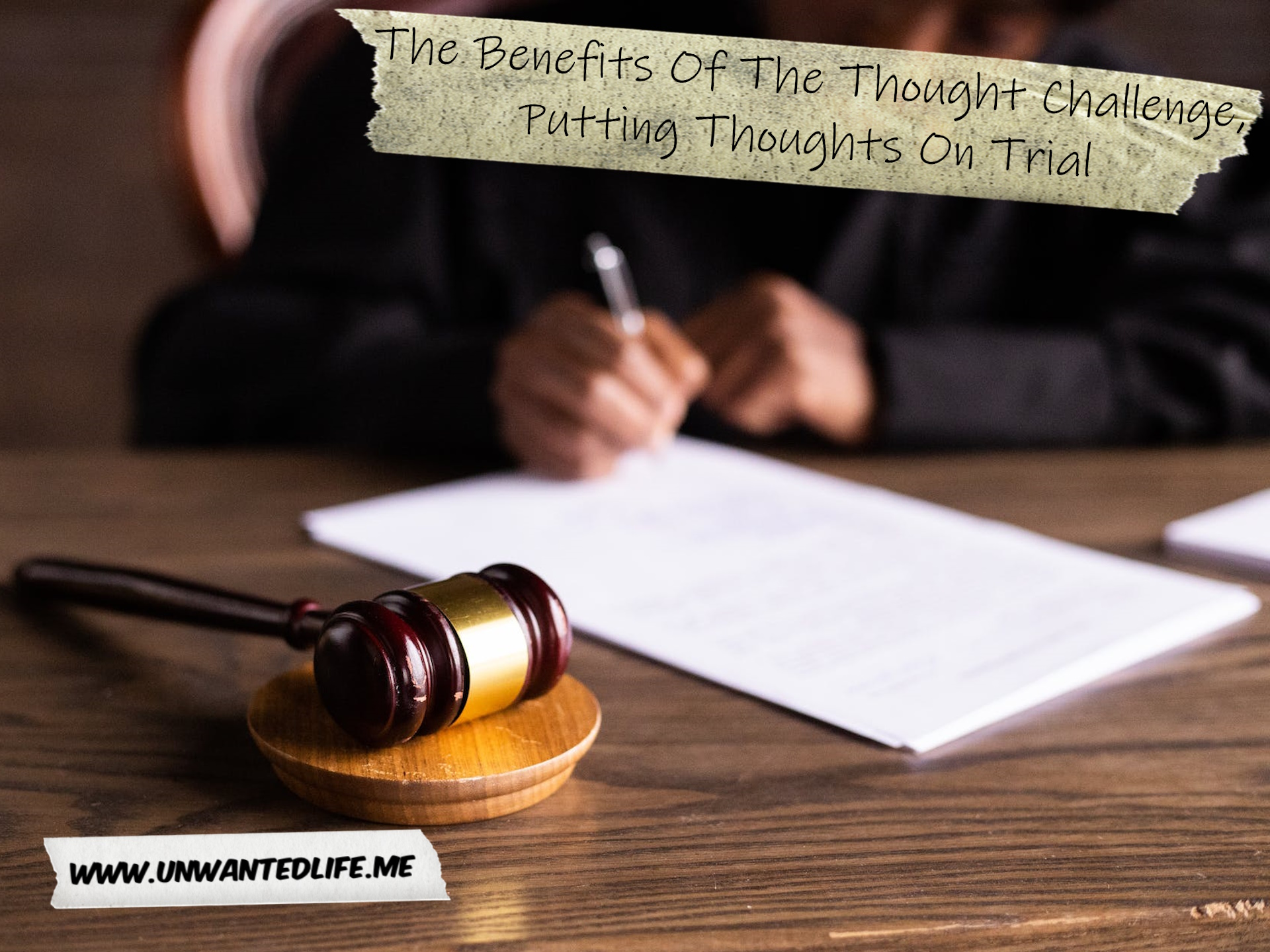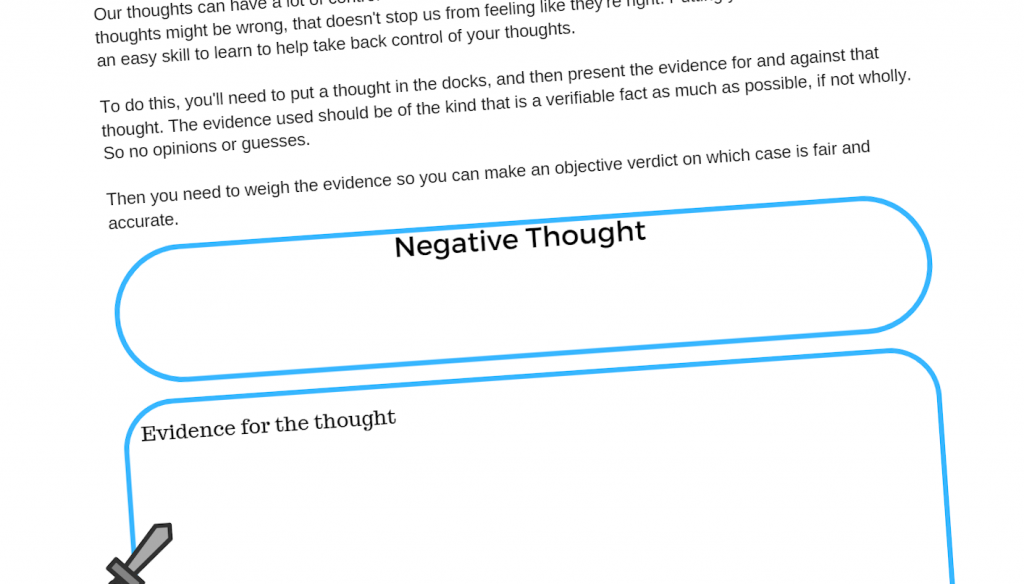We can all develop negative intrusive thoughts, with or without a clinical mental health diagnosis, which can show a range of cognitive biases we are engaging in or developing. But there are ways to overcome these negative intrusive thoughts, and one such method used in cognitive–behavioural therapy (CBT) is thought challenges, one of which is called putting your thoughts on trial.
Disclosure: This article contains links to my Unwanted Life Shop. Read my full disclosure here.
What Is Putting Your Thoughts On Trial
CBT emphasises the issue of unhelpful thinking that we can develop, which shapes how we perceive the world around us. This perception can then influence our behaviours, leading to negative behavioural changes. As Williams and Garland (2002) stated, if someone thinks that other people don’t like them or sees the world as bleak, then that person is likely to feel more depressed and/or anxious.
Putting your thoughts on trial is a thought-challenging technique that can help you to identify and challenge negative or irrational thoughts. It involves examining your thoughts objectively and critically, considering whether they are based on evidence or assumptions.
The most important part of this thought challenge is to challenge the thought from a point of objectivity. It’s easy to get lost in our subjectivity, but if you’re able to take an objective view, then it can be easier to see what is harming you in your subjective perspective.
Thus, it can be beneficial to step back, examine the evidence for your thoughts, and explore alternative ways to look at a given situation (NHS).
The Benefits Of Putting Your Thoughts On Trial
Putting your thoughts on trial by using this CBT technique allows you to question and examine your thoughts more objectively and can transform your thinking in helpful ways. But it does have to involve critically examining and challenging your thoughts or beliefs. If you can do this, then this process offers several benefits:
Increased self-awareness
By putting your thoughts on trial, people become more aware of their negative intrusive thoughts or negative thinking patterns. Thus, the process of putting your thoughts on trial can help you to become more aware of your own thought patterns and how they affect your emotions and behaviours.
Improved cognitive flexibility
It encourages people to consider alternative perspectives or interpretations of situations, promoting a more flexible and adaptive way of thinking. This is what we often refer to as reframing.
Reduced negative thinking
By examining your thoughts more critically, you can develop the skill of identifying and challenging those negative or irrational thoughts before they spiral out of control.
Empowerment and control
Putting your thoughts on trial empowers people to take control of their thinking process, fostering a sense of agency over their mental health and wellbeing. Often, when we feel a loss of control, it has a significant impact on our mental wellbeing. Engaging in thought challenges like putting your thoughts on trial helps retain or return that sense of loss of control.
Improved decision-making
When you are better able to distinguish between rational and irrational thoughts, you can make more informed and balanced decisions.
Enhanced emotional regulation
It’s easy for us as emotional beings to confuse emotions for facts, a common cognitive bias any of us can develop. There’s also the issue of the cognitive bias of dichotomous thinking, better known as black-and-white thinking.
When we understand the link between our thoughts and emotions, we can develop more effective coping mechanisms for dealing with difficult emotions. Evaluating such extreme black-and-white thinking will tone down knee-jerk reactions, making our responses calmer.
By evaluating the validity and accuracy of our thoughts, people can gain better control over their emotional responses, leading to reduced stress and anxiety. Reducing our cognitive bias, because this thought-challenging technique helps identify and challenge cognitive bias (e.g., black-and-white thinking, catastrophizing, etc.) that may lead to negative emotions or behaviours.
Positive behavioural changes
Challenging negative or unhelpful thoughts often leads to more positive behaviours and healthier coping strategies in response to various situations.
Improved problem-solving
By assessing thoughts more objectively, individuals can develop more effective problem-solving skills, leading to better decision-making. This happens because putting thoughts on trial gets us to ask ourselves probing questions that separate reasoned facts from limiting assumptions. This builds more accurate thinking and allows us to develop better problem-solving skills.
Defuses anxiety
Rather than believing every worrisome thought, test it. This slows rumination and panic. It can be an effective way to stop your anxiety in its tracks, although it doesn’t work for everyone. For me, learning to accept my thoughts and leaving them unchallenged so they become background noise was the strategy that worked for me. Although this can be a lot harder to do than engaging in thought challenges like putting your thoughts on trial. It’s also worth noting that this was for my specific anxiety thoughts that could lead to a psychotic episode.
Boosts confidence
Reframing distorted negative self-talk into balanced truths based on evidence reinforces self-worth.
Sparks personal growth
Constructively challenging comfort zones and habitual reactions (how we think, feel, and respond to situations) will open the mind to constructive alternative perspectives that are more helpful than the ones we may be having.
Strengthens relationships
Recognising misinterpretations or biases improves social dynamics as faulty assumptions get cleared up. It’s all too easy for our minds to lie to us through the use of negative intrusive thoughts that can harm a relationship if left unchallenged. Thus, challenging these thoughts can help with maintaining a healthy relationship.

How To Put Your Thoughts On Trial
Identify the thought
When you are feeling stressed, anxious, or upset, pay attention to the thoughts that are going through your mind. It can help to collect such thoughts in a journal so you can challenge them in “court” when you have more time. This will allow you to ask yourself, “What are you telling yourself about the situation?”.
Challenging the thought
For the prosecution, you’ll want to find evidence that supports the negative thought. In this role, you’ll try to prove the negative thought is true (Psychology Tools).
Once you’re done with being the prosecution, you’ll now take the role of the defence, whereby you’ll question the accuracy and usefulness of the thought. You’ll also challenge the evidence presented by the prosecution, where skills like reframing can be useful. Another thing you can do is outline occasions where your thoughts on trial weren’t true.
As part of the defence, try to see the situation from different angles. What would someone else say about the situation? What would a more objective person say? Once you have challenged and considered the thought, reframe it into a more positive, neutral, or realistic perspective.
Verdict
Like any trial, there needs to be a verdict. So after going through the evidence for and against the negative thought being true, decide on what verdict an objective person would give?
Practice regularly
The more you practise putting your thoughts on trial, the more adept you will become at identifying and challenging negative or irrational thoughts. This is a good skill to learn to help prevent poor mental health or to prevent poor mental health from further declining.
My ‘Putting Your Thoughts On Trial’ Worksheet
Because of the usefulness that putting your thoughts on trial can have on developing a more positive mindset, I created a handy worksheet to use with my clients to help them develop the skill. And now I’m making it available to everyone in my blog’s shop. Use this worksheet to help develop the skill of challenging your thoughts so you can become the master of your own mind.
You can find my ‘Putting Your Thoughts On Trial’ worksheet over at my shop by clicking here.
Summary
It is important to note that putting your thoughts on trial is not about suppressing or denying your emotions or thoughts. Instead, it is about developing a healthier relationship with your thoughts by recognising that not all of them are accurate or helpful. By challenging your negative thoughts and replacing them with more positive, neutral, and rational ones, you can reduce stress, improve your mood, and make better decisions.
By developing the habit of judiciously questioning thoughts like a lawyer in a courtroom, the mind becomes more flexible, receptive, and psychologically resourceful. Thus, by engaging in the cognitive process of putting your thoughts on trial, people can reframe negative thinking patterns, develop a more positive mindset, and ultimately improve their overall mental and emotional wellbeing.
As always, leave your feedback in the comments section below. Also, please share your experiences with thought challenges and putting your thoughts on trial in the comments section below as well. Don’t forget, if you want to stay up-to-date with my blog, then sign up for my newsletter below. Alternatively, click the red bell icon in the bottom right corner to get push notifications for new articles.
Lastly, if you’d like to support my blog, you can make a donation of any size below. Until next time, Unwanted Life readers.
References
Williams, C., & Garland, A. (2002). Identifying and challenging unhelpful thinking. Advances in Psychiatric Treatment, 8(5), 377-386. Retrieved from https://www.cambridge.org/core/services/aop-cambridge-core/content/view/6A41268D959EC97545859A9EAA8065B0/S1355514600010981a.pdf/identifying_and_challenging_unhelpful_thinking.pdf.




Putting thoughts on trial? OK, count me in. A fascinating dive into our thought challenges as well as benefits.
Let me know how it works out
This was such an enjoyable read! I like the idea of putting your thoughts on trial, it take a lot of skill to do it but the benefits are unmeasurable! I love reading about reframing negative thoughts because it really does shift my mood and helps out a ton!
Engaging in thought challenges really can be beneficial to our wellbeing. Thanks for commenting
My therapist and I have been working on this.